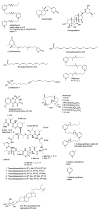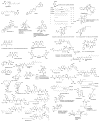Marine pharmacology in 2000: marine compounds with antibacterial, anticoagulant, antifungal, anti-inflammatory, antimalarial, antiplatelet, antituberculosis, and antiviral activities; affecting the cardiovascular, immune, and nervous systems and other miscellaneous mechanisms of action
- PMID: 14583811
- PMCID: PMC4934889
- DOI: 10.1007/s10126-003-0007-7
Marine pharmacology in 2000: marine compounds with antibacterial, anticoagulant, antifungal, anti-inflammatory, antimalarial, antiplatelet, antituberculosis, and antiviral activities; affecting the cardiovascular, immune, and nervous systems and other miscellaneous mechanisms of action
Abstract
During 2000 research on the pharmacology of marine chemicals involved investigators from Australia, Brazil, Canada, Egypt, France, Germany, India, Indonesia, Israel, Italy, Japan, the Netherlands, New Zealand, Phillipines, Singapore, Slovenia, South Korea, Spain, Sweden, Switzerland, United Kingdom, and the United States. This current review, a sequel to the authors' 1998 and 1999 reviews, classifies 68 peer-reviewed articles on the basis of the reported preclinical pharmacologic properties of marine chemicals derived from a diverse group of marine animals, algae, fungi, and bacteria. Antibacterial, anticoagulant, antifungal, antimalarial, antiplatelet, antituberculosis, or antiviral activity was reported for 35 marine chemicals. An additional 20 marine compounds were shown to have significant effects on the cardiovascular and nervous system, and to possess anti-inflammatory or immunosuppressant properties. Finally, 23 marine compounds were reported to act on a variety of molecular targets and thus could potentially contribute to several pharmacologic classes. Thus, as in 1998 and 1999, during 2000 pharmacologic research with marine chemicals continued to contribute potentially novel chemical leads to the ongoing global search for therapeutic agents in the treatment of multiple disease categories.
Figures




References
-
- Adams AC, Layer RT, McCabe RT, Keefe KA. Effects of conantokins on L-3,4-dihydroxyphenylalanine-induced behavior and immediate early gene expression. Eur J Pharmacol. 2000;404:303–313. - PubMed
-
- Aoki S, Matsui K, Tanaka K, Satari R, Kobayashi M. Lembehyne a, a novel neuritogenic polyacetylene, from a marine sponge of Haliclona sp. Tetrahedron. 2000;56:9945–9948.
-
- Awad NE. Biologically active steroid from the green alga Ulva lactuca. Phytother Res. 2000;14:641–643. - PubMed
Publication types
MeSH terms
Substances
Grants and funding
LinkOut - more resources
Full Text Sources
